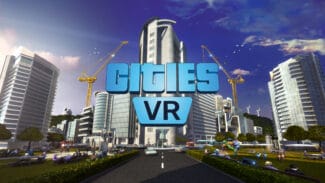Cities: VR is available now, bringing a reworked version of the original PC game, Cities: Skylines, to Quest 2. However, while this new release retains a lot of the original’s spirit, the end product leaves a lot to be desired. Read on for our Cities: VR review.
It’s a tale of two cities for Quest owners at the moment, with two simulation games — Cities: VR and Little Cities — releasing within weeks of one another. The former is adapted from a PC game, while the latter is a completely original title, built from the ground up for VR. While Little Cities was set to release first, it was pushed back to early May and so Cities: VR is first out of the gate, available this week exclusively for Quest 2.
Over the last few weeks, it became clear that Little Cities would take a calmer, more native approach to the genre with a pleasant aesthetic style. On the other side, Cities: VR looked set to provide more complex, detailed simulation aspects taken from the original PC game, perhaps at the cost of visuals.
An Authentic Skylines Experience
By and large, this assessment rings true. At its core, Cities: VR is a tweaked version of Cities: Skylines from PC. Modified for VR, the game presents the vast majority of the core Skylines experience on Quest. Some features have been stripped back, modified or omitted (such as natural disasters or editing terrain), but it’s clear developer Fast Travel Games has worked closely with Paradox Interactive and Colossal Order to ensure Cities: VR feels authentic to the experience players know and love.

The gameplay loop remains the same – you start on a blank map with nothing, and gradually build out your city with roads, zones and services. You unlock more services and city elements as your population increases, which ups the complexity of both city design and management. You’ll need to find the right pace of expansion, ensuring you’re able to make a profit while also keeping the population happy.
All of the core Skylines tenets are available here – road planning (with curved roads and varying sizes), zoning, budget and tax management, transport, emergency services, education, utilities and more. If you’ve played Skylines, Cities: VR will feel very familiar.
This expansive selection of options, and the ability to plan your city however you like, is the biggest strength of the game. Cities: VR wants to offer you as many options as possible – almost too many.
The focus of your city is up to you. You can plan it out meticulously, aesthetically aligning street grids with perfect curves, good traffic flow and equidistant core services to form a perfect city. Or, you can pay little attention to optimisztion and place freeform roads all over the place, fixing problems as they emerge. There’s a lot of depth to be found in the expansive set of tools and how you approach them.
Disappointing Visuals
This is all a good starting point, but in practice the game isn’t quite as successful in making this transition to VR as one would hope. Primarily, the visuals pose a few problems and struggle to deliver an acceptable experience on Quest 2’s standalone hardware.
Object pop-in – trees, shadows, buildings, almost everything – is a consistent and huge problem. Items pop in and out of view regularly as you look around the map, sometimes seconds late. Texture quality is low and almost all objects display significantly jagged edges from afar, which gives the maps a shimmering, hazy quality. Foveated rendering is also employed with a heavy hand and it’s extremely distracting.
It’s hard to stay immersed with all of these issues, and your eyes never feel properly settled on the map. Even putting the technical issues aside, the game is still incredibly visually uninteresting and bland compared to the spectacle of Skylines. Buildings lack depth, trees are spindly, the lighting is flat and shadows are inconsistent. At night, streetlights are completely missing or unlit, and building lights aren’t enough to properly light the map.
To its credit, Fast Travel has retained some tiny visual easter eggs like detailed building animations, but it’s quite clear that Quest 2 simply can’t run something of this scale at the standard you’d hope in 2022. As a result, the satisfaction of watching your city spring to life — a key part of what made Skylines so good — is almost completely lost in Cities: VR.
Structurally Unsound
When it comes to a campaign, there isn’t much in place to guide players. There is essentially no formal structure or campaign. A 10-minute tutorial is available on every map, but all maps are unlocked from the start and each of them has the exact same city milestones and progression path. After finishing the tutorial, you can simply choose to start a new game – with the exact same progression and conditions – on any map.
But without the ability to expand beyond the initial square grid, there’s little reason to pick one over the other. Even adding in map scenarios — giving players options to choose alternate win conditions or work with different unlock progressions — would have given players a bit more to latch onto.
Granted, this is the same approach taken by Cities: Skylines, but it feels more hollow in Cities: VR, especially given how many Quest players might be new to the franchise and how much more limited the game is. The tutorial itself isn’t enough for new players either – you’ll be taught the absolute basics (controls, laying roads, zoning) but be left without much guidance on the rest of the game.

There is a sandbox mode for each map as well (unlimited money, all elements/services unlocked from the get go), but there’s a lot less satisfaction in designing your dream city and watching it come to life when the visuals are so hampered.
There are other minor omissions that aren’t deal-breakers but are nonetheless questionable. There’s seemingly no auto-save for example, nor is there any way to set a custom name for your city or save file. You can bulldoze structures you didn’t intend to place, but there’s no cost-free undo/redo feature which is a problem when you’re dealing with easily misplaced VR controls.
Omissions and Interactions
Skylines featured lots of complex menus and options for selecting tools and elements. While bringing all that to VR is admittedly a difficult task, tool selection, menus and controls are very clunky in Cities: VR.

Menus are displayed as giant floating boxes in the sky and feel completely unintuitive for a VR headset. The selection system and control scheme is confusing and extremely imprecise. You’ll constantly make mistakes or have to double check what you’ve got selected. You get a bit more used to it over time, but it doesn’t come close to the zippy tools and UI in Little Cities.
There’s also no way to scale the world, which is a puzzling decision. There is a street view camera, but the main camera view has an adjustable height (which feels a little too far away from the city at times), paired with a camera angle that encourages looking straight down at the floor. Not only is it bad for neck strain and comfort, but it makes the city look quite flat. Little Cities’ scaleable, isometric camera view works way better for VR.
Cities VR Review – Final Impressions
All-in-all, Cities: VR is a confusing release that feels a tad aimless and unfinished. It does successfully bring most of the core Skylines elements over to VR with some of that 3D novelty intact, and the breadth of customization options available is a real strength. But it doesn’t feel as satisfying to play in VR as it should. In fact, there’s nothing that this version does better than the original.
It’s a shame, because theoretically the genre is a perfect fit for such an immersive and tactile medium. But, with a finnicky UI and technical hiccups, Cities: VR doesn’t successfully leverage that, making it hard to recommend even for newcomers to the franchise. This is a stripped-down, visually-disappointing version of Cities: Skylines. If you’re looking for a complex city simulation game, you’d be better off just playing that instead.
UploadVR recently changed its review guidelines, and this is one of our new unlabelled review categories. You can read more about our review guidelines here.
This review was conducted on Meta Quest 2. What did you make of our Cities VR review? Let us know in the comments below!





